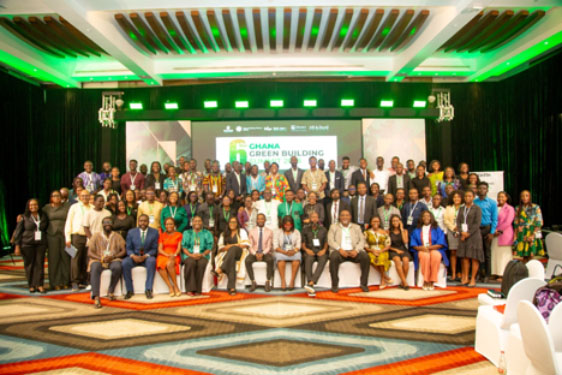Summit participants in a group photograph
The 6th edition of the Ghana Green Building Summit has been held in Accra, bringing together more than 300 stakeholders from government, development institutions, academia, the private sector, and civil society to deliberate on the critical role of sustainable buildings in shaping Ghana’s future.
Held under the theme, ‘Reimagining Buildings and Cities for Economic and Social Prosperity’, the Summit provided a robust platform for dialogue, innovation, and collaboration. The overarching message was clear and emphatic: sustainable buildings are not a luxury reserved for the elite; they can and must be affordable.
Convened by Cyril Nii Ayitey Tetteh, the Summit reinforced the idea that sustainability is fundamentally about longevity, resilience, and inclusion.
“Sustainability is all about continuity. This happens when we embed sustainability into business, adopt processes with ESG frameworks and practise sustainable banking principles,” he noted in his welcome address.
The Minister for Works, Housing and Water Resources, Kenneth Gilbert Adjei, affirmed the government’s determination to make green building practices central to national development policies.
“We are actively integrating green building principles into our national housing strategies and programmes,” he stated.
The Minister of State for Climate Change and Sustainability, Issifu Seidu outlined Ghana’s broader climate response strategy.
In a speech read on his behalf by Cedric Dzelu – Technical Director to the Minister of State in charge of Climate Change and Sustainabilty, he cited alarming World Bank projections that climate-induced economic losses could triple by 2050, with over 30 million Ghanaians potentially exposed to extreme heat.
He called on builders to design cities not merely with bricks and mortar, but with vision and purpose. “Let us then design cities that breathe. Cities that include. Cities that endure, he noted.
From the International Finance Corporation (IFC), Paul Kwesi Ocran, Green Buildings Lead, Ghana, delivered an in-depth presentation on the technical dimensions of green building in the country.
“We should not always look at green buildings as three-storey buildings or the iconic ten-storey towers. Your home can also be green,” he said.
Citing examples from Accra and Tamale, Ocran detailed how low-tech design interventions—like reflective roofing and efficient lighting—have resulted in over 30 percent energy and water savings in affordable housing projects.
Also addressing participants, Vera Owusu-Osei, Partner and Co-Chair of the Green Transition Practice at AB & David Africa, framed the summit as a model for how legal frameworks, investment strategies, and environmental priorities can intersect.
“Today’s conversations are a testament to what is possible when innovation, policy, and legal support align,” she said.
From the British High Commission, Richard Sandall, Development Director, emphasised the importance of systems thinking and leadership.
“Green buildings are not a luxury. They are a necessity,” he said. He urged stakeholders to think beyond technology and focus on the commercial and political systems that shape value and demand.
The Summit concluded with a broad coalition of partners now aligned to deliver affordable, inclusive, and sustainable cities—one green home at a time.
By Janet Amponsah


